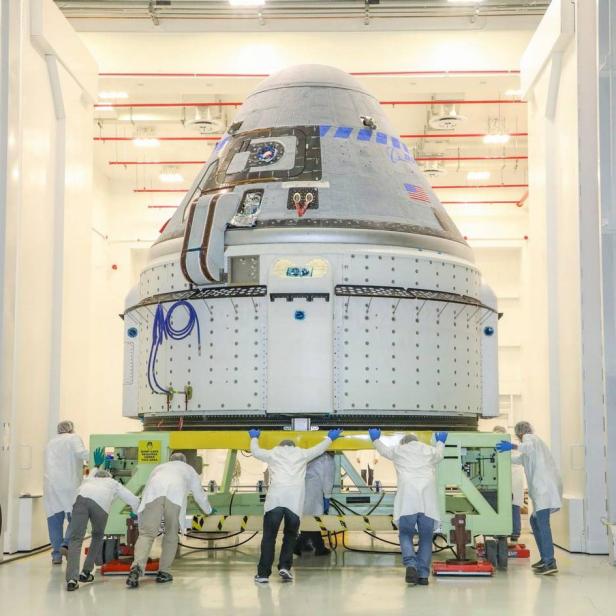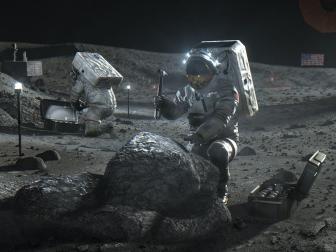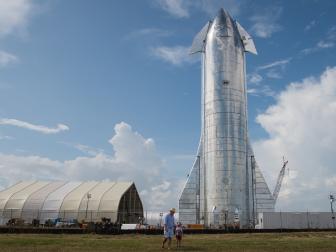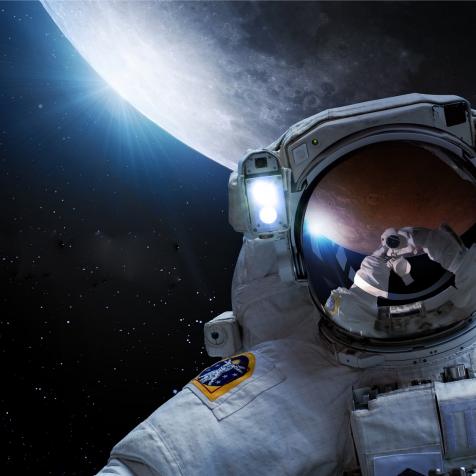
Boeing/NASA
Looking Ahead to 2021 in Space
As the year 2020 comes to close, it’s time to look ahead to 2021 and what’s to come in space exploration. From crewed launches to the ISS and Perseverance landing on Mars, it’s shaping up to be a busy year in space. Let’s take a look!
NASA’s Perseverance Rover
The Mars 2020 Perseverance Rover launched on July 30, 2020, from Cape Canaveral Air Force Station, Florida. It is scheduled to land February 18, 2021, at the Jezero Crater on Mars. Perseverance's mission is to seek signs of ancient life, and collect rock, as well as soil samples for possible return to Earth.
NASA's Ingenuity Mars Helicopter
The Mars Helicopter launched strapped to the belly of the Mars Rover on July 30, 2020, from Cape Canaveral Air Force Station, Florida. It is scheduled to land February 18, 2021, at the Jezero Crater on Mars. Ingenuity is the first aircraft to attempt flight on the Red Planet. It has the same goal as Perseverance, to find any signs of habitable life on Mars.
Boeing’s CST-100 Starliner
Boeing’s uncrewed Orbital Flight Test 2 is scheduled for March or April of 2021. Boeing's first Starliner mission and uncrewed test flight, Orbital Test Flight 1, launched into space on an Atlas V rocket in 2019, but failed to reach its intended orbit due to software errors and a communications dropout during the flight.
Crew-1 Return
NASA astronauts Michael Hopkins, Victor Glover, and Shannon Walker, along with Soichi Noguchi of the Japan Aerospace Exploration Agency launched in a new SpaceX Crew Dragon spacecraft atop a Falcon 9 rocket on November 15, 2020, at 7:27P ET from the NASA Kennedy Launch Complex 39A. After a 27-hour journey, the spacecraft docked with the ISS on November 16, 2020, at 11:01P ET. Crew-1 is staying aboard the ISS for about six months. They are scheduled to return home in April or May 2021 via a splashdown.
Journey to the ISS: NASA's SpaceX Crew-1 Mission 14 Photos
(Updated: November 17, 2020) From launch preparation on land to docking with the ISS in space, here are some highlights from the NASA and SpaceX Crew-1 mission. NASA astronauts Michael Hopkins, Shannon Walker, and Victor Glover, along with Soichi Noguchi of the Japan Aerospace Exploration Agency launched in a new Crew Dragon spacecraft atop a Falcon 9 rocket on November 15 at 7:27P ET from the NASA Kennedy Launch Complex 39A. After a 27 hour journey, the spacecraft docked with the ISS at 11:01P ET.
Expedition 64 Return
Expedition 64 is scheduled to return home from the ISS in April 2021 via a parachute-assisted landing in southeast of Dzhezkazgan, a remote town in Kazakhstan. The mission began October 14, 2020, as NASA astronaut Kate Rubins, Roscosmos cosmonaut Sergey Ryzhikov, and Roscosmos cosmonaut Sergey Kud-Sverchkov launched to the ISS aboard a Soyuz MS-17 spacecraft from the Baikonur Cosmodrome in Kazakhstan.
Expedition 64 to Launch on October 14
One NASA astronaut and two Roscosmos cosmonauts of Expedition 64 are scheduled to launch to the ISS on Wednesday, October 14 at 1:45AM ET for a six month stay. Let’s learn the details!
Expedition 65 Launch
Roscosmos cosmonauts Oleg Novitsky, Pyotr Dubrov, and Sergey Korsakov will launch aboard a Soyuz MS-18 from the Baikonur Cosmodrome in Kazakhstan in April of 2021 to the International Space Station following the departure of Expedition 64. Novitsky, Dubrov, and Korsakov’s mission is scheduled to last roughly six months on the ISS.
Artemis I
NASA is planning to land the first woman and next man on the moon in 2024. Through a US government-funded human spaceflight program known as Artemis, there may be human footprints on the south pole region of the lunar surface in the very near future. In or around April 2021, NASA aims to launch Artemis I, an uncrewed flight test of the Orion spacecraft. it will travel 280,000 miles from Earth in the direction of the Moon, pass it, and not land on its lunar surface. If all goes to plan, Artemis I will return to Earth after spending the most time in space out of any spacecraft without docking to the ISS.
NASA’s Plan for Returning to the Moon
NASA is planning to land the first woman and next man on the moon in 2024. Through a US government-funded human spaceflight program known as Artemis, there may be human footprints on the south pole region of the lunar surface in the very near future. From understanding the Artemis Program to the Gateway, let’s explore the lunar details.
Crew-2 Launch and Return
The NASA and SpaceX Crew-2 launch will be the second crewed operational flight of a Crew Dragon spacecraft. NASA astronauts Shane Kimbrough and Megan McArthur along with Akihiko Hoshide of JAXA as well as Thomas Pesquet of ESA will be launching in Endeavor, a SpaceX Crew Dragon atop a Falcon 9 rocket, from the NASA Kennedy Launch Complex 39A in April or May 2021. They will be staying aboard the International Space Station for about six months.
Boeing CST-100 Starliner Crewed Test Flight
After a successful Orbital Flight Test 2, Boeing and NASA will fly Starliner's first crewed mission, the Crew Flight Test, currently targeted for no earlier than June 2021, with the first post-certification mission, called Starliner-1, tentatively scheduled for no earlier than late December 2021.
NASA Astronaut Jeanette Epps
It was announced this week that Astronaut Jeanette Epps will be added to NASA's Boeing Starliner-1 mission to the international Space Station. She will be the first Black astronaut to live on the ISS.
Crew-3 Launch
NASA astronauts Raja Chari and Tom Marshburn as well as ESA astronaut Matthias Maurer have been chosen for the NASA and SpaceX Crew-3 mission which may launch to the International Space Station in the fall of 2021 from the NASA Kennedy Launch Complex 39A. Chari, Marshburn, and Mauerer, will be aboard the station for roughly six months.
James Webb Space Telescope
The James Webb Space Telescope is a large infrared telescope with a 6.5-meter primary mirror. The telescope will be launched on an Ariane 5 rocket from French Guiana in late October or early November 2021. The Webb telescope will study every phase in the history of our Universe, ranging from the first luminous glows after the Big Bang, to the formation of solar systems capable of supporting life on planets like Earth, to the evolution of our own Solar System.
Virgin Galactic’s SpaceShipTwo
Before the end of 2021, Richard Branson is scheduled to take a crewed flight on Virgin Galactic’s SpaceShipTwo named Unity. Soon after Branson’s trip, Virgin Galactic will begin flying private citizens to the edge of space and back for the cost of $250,000 per ticket.
Out of This World! Inside Virgin Galactic's Spacecraft
Buckle up! On July 28, Virgin Galactic is showing the world what the inside of their SpaceShipTwo Unity spacecraft looks like via a livestream on their YouTube channel.
SpaceX’s Starship
Elon Musk’s SpaceX is developing a reusable transportation system for spaceflight. Starship, accompanied with a Super Heavy rocket, is a type of reusable transportation that is designed to carry passengers and cargo to the Moon and Mars. This commercial vehicle is key to establishing a human city on Mars. When paired with the Super Heavy booster, Starship stands at about 400 feet tall. Each prototype, the latest this year being SN8, goes through rounds of tests which will continue into 2021. These test launches occur at SpaceX’s site in Boca Chica, Texas.
Fly Me to the Moon and Mars: SpaceX’s Starship and Spaceports
Elon Musk’s SpaceX is developing a reusable transportation system for spaceflight to the Moon, Mars, and beyond our wildest space dreams.
Blue Origin
Blue Origin's future New Glenn launch vehicle will join NASA's fleet of commercial launch vehicles for flights in the mid-2020s. While there is no estimated date for New Glenn’s first launch, it could happen by the end of 2021.


















